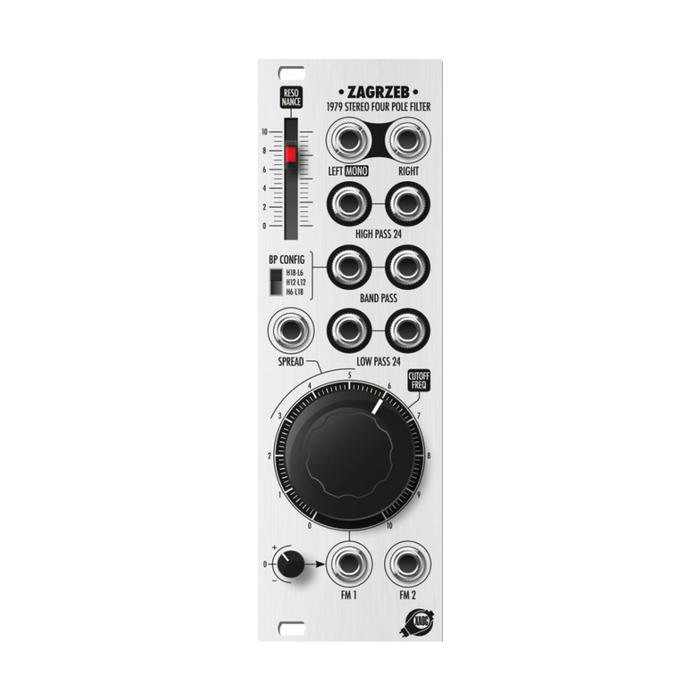
Xaoc Devices Zagrzeb
Format: Eurorack
Width: 8HP
Depth: 31mm
Current: 70mA @ + 12V, 60mA @ -12V
English Manual (pdf)

Format: Eurorack
Width: 8HP
Depth: 31mm
Current: 70mA @ + 12V, 60mA @ -12V
English Manual (pdf)
Xaoc Devices Zagrzeb is a 5-pole stereo multimode SVVCF with 4 different frequency characteristics.HP, BP, LPThis unit, which can use three stereo signals at the same time, is designed to provide a smooth and clean sound unless it is overdriven by a high-amplitude signal.Its sound quality is reminiscent of the famous Japanese synthesizer, but Zagrzeb's 3-pole stereo variable structure is not a clone of the existing design but a newly developed one.The unit is also designed to filter the stereo signals of samples and stereo oscillators like Odessa, but it can also handle monaural signals easily, thanks to a special phase shift network in the input stage.Pseudo stereo pairHas the ability to create.
Zagrzeb is a variable state filter that can output multiple outputs.A typical 2-pole filter provides a 12dB / Oct lowpass, a + 6 / -6dB bandpass, and a + 12dB / Oct highpass response.Of this machine4 polesIn the structure, from a low pass of -24dB / Oct to a high pass of + 24dB / Oct.5 different characteristicsProvide.These combinations cover a wide spectrum and are achieved in stereo with different variations of the bandpass consisting of asymmetric + 6 / -18dB, symmetric + 12 / -12dB, and asymmetric + 18 / -6dB.
The figure below fig.2 shows the unit.HIGH PASS 24とLOW PASS 24An example of frequency characteristics at the output is shown.Notice that the low frequencies are not attenuated even at high resonance settings and the high pass response is particularly steep at 24dB / Oct.The result is a radical filtering effect.

The figure below fig.3 isBP CONFIGThree settings for the switch (H18L6, H12L12, H6L18) Are compared and the frequency response of the BAND PASS output pair is shown.Due to the difference in slope, the filtering intensity of the components above and below the center frequency of the cutoff changes, and the tone color changes significantly. Notice that the symmetric response of the H12L12 has two 2dB / Oct slopes, which are twice as steep as the classical two-pole SVF.

In any resonant circuit, increasing the resonance value introduces a high gain in the signal close to the resonant frequency.For filters, this can increase the amplitude of the filtered signal and cause distortion at the output.Synthesizer filter designers can solve this problem by mixing inverting inputs with variable feedback that controls resonance to complement the gain gain, by introducing non-linear saturation to the variable feedback, or by using advanced dynamics processing. Apply or deal with it either way.The feedback of this unit is fixed, and the control of resonance is executed by shifting each pole of the transfer function, not by changing the feedback.By trimming the resonance range without compensating for the increased gain, a smooth and natural response to the clipping point is achieved, and reaching the clipping point is rare.This is also one of the reasons why this unit was designed so that it cannot oscillate by itself.
Two CV inputs located at the bottom of the front panel control the cutoff frequency over the entire audio range.Variable typeFM 1The input is equipped with an Athenu barter with a detent claw.The range of this knob is up to ± 0.5V / Oct (± 2oct / V), and the response is fixed.FM 2It is twice as wide as the input.This allows for extreme sweeps while maintaining shallow modulation near the center position due to the potentiometer's decay curve.The fixed FM 2 input is uncalibrated, but provides approximate and accurate 2V / Oct tracking.
Zagrzeb not only can perform filtering of the same characteristics on two channels of the stereo signal, but also makes subtle changes in the cutoff frequency to achieve stereo image animation. Adjusted to 2/2 sensitivity of FM 1 inputSPREAD CVThe input slightly rocks the two stereo filters in opposite directions on the incoming CV on the positive or negative electrode.Of this machineLEFT / MONOSimply patch the input to a monaural signal to create a pseudo-stereo effect.A special multi-stage phase shifting network implemented in the input stage creates a vast image stereo output signal by introducing a slight delay between the left and right outputs.To better see this effect, use a rich sound that changes over time.
The filtered signal is taken from the HI PASS 24 output and the inverted one is mixed (subtracted) with the signal from the LOW PASS 24 output.This willNOTCHYou can easily create a response signal.To better see this effect, set RESONANCE to the minimum value.
When using this unit in monaural, it is interesting to mix the two detuned bandpass outputs.Formant filterYou can get the response of. Patch the SPREAD input with an offset voltage of 5-10V to mix the two BAND PASS outputs. Set RESONANCE high.
By stacking the two channels of this unit, it is steep.48dB / OctYou can get a low-pass / high-pass response.To create a low pass, patch the audio signal to the left channel and input the LOW PASS 24 left output signal to the right channel.The final output uses the right output of the LOW PASS 24.